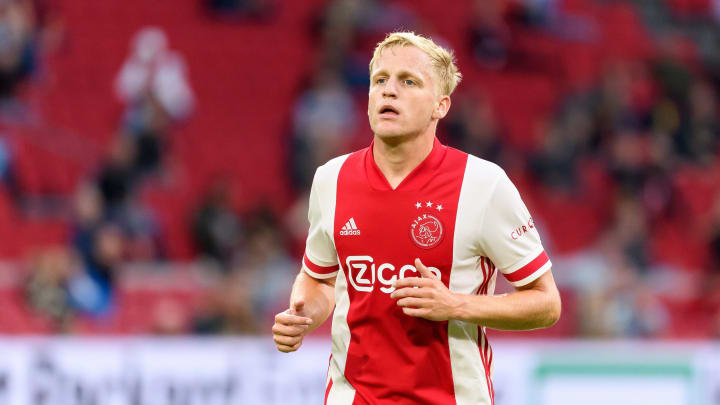
It’s taken them a while, but Manchester United are finally up and running in the transfer market this summer!
The Red Devils have completed the signing of midfielder Donny van de Beek from Ajax in a deal thought to be around £40m. When it first emerged United were closing in on the Dutchman’s signature recently, it came as quite a pleasant shock to many fans as all the talk had been focused on other targets such as Jadon Sancho.
Indeed, the speed at which the negotiations moved was refreshing, if not somewhat surprising. Van de Beek – a versatile midfielder who’s capable of playing in a more advanced role as well as slightly deeper – will add strength in depth in the centre of the park and will increase the competition for places. Most crucially, however, he fits the exact profile of the type of player Ole Gunnar Solskjaer is after.
And this is all for a very reasonable price – especially considering he is still only 23.
But with Paul Pogba and Bruno Fernandes certain starters for United next term, questions have been raised as to whether Van de Beek has been brought in with the promise of starting games regularly or if he will initially take up a squad rotation role.
However, one of the most exciting things about the signing of Van de Beek is the different options he will offer to Solskjaer. The Norwegian opted to typically utilise a 4-2-3-1 formation in 2019/20 for his strongest side, with Nemanja Matic and Pogba playing slightly deeper behind Fernandes after his January arrival
Pogba, however, was given the freedom to operate in a more box-to-box role when he returned from injury, allowing him to influence games through his range of passing and movement. Following the resumption of play, Matic quickly became the first-choice defensive midfielder as he provided the platform for Pogba and Fernandes to shine with his intelligent reading of the game.
Indeed, It was clear to see the lack of balance within the midfield when he was missing.
In Van de Beek, United have an extremely clever midfielder who can play in both an offensive role as well as slightly deeper. In matches against so-called lesser sides, Solskjaer could continue to deploy his preferred 4-2-3-1, with Van de Beek replacing Matic. In this system, Pogba and Van de Beek would act as the box-to-box midfielders, dictating games from deep when on the ball and sniffing out danger when out of possession.
Sure, it’s a very attacking setup, but it will be a fluid system with Fernandes and Van de Beek likely to alternate as the ‘number ten’. Now, of course, it could be a risky tactic if he were to select such a midfield against a ‘top six’ side, but when dominating possession against ‘lesser’ clubs, why not start your three best midfielders in the preferred formation?
One question on many fans’ minds is how on earth Solskjaer will line up in midfield in the bigger games – such as in the Champions League and against ‘big six’ sides. The reality of the matter is that he could well opt to go with his tried and trusted combination of Matic, Pogba and Fernandes initially.
After all, Man Utd don’t need to start Van de Beek every game. However, one way the Norwegian could start all three and provide extra solidity in midfield is to deploy a diamond formation – like he did against Everton last season.
On that occasion, Matic sat at the base of the diamond, with Fred and Scott McTominay playing in box-to-box roles behind Fernandes. Did it work against Everton? Well…not really, even if there were some encouraging signs.
But this could be a very dangerous set up with Pogba and Van de Beek coming into the midfield.
With this midfield setup, there would be countless different avenues to break through the opposition’s defence, especially if the full-backs push forward to support the attack. Creativity, energy, defensive solidity and world class talent, what more could Solskjaer want?
The potential lack of width in the diamond formation may not be an appealing long-term proposition for Solskjaer, however. Alternatively, he could look to set up his side in a 4-3-3 formation, with three flat midfielders in Van de Beek, Pogba and Fernandes. This system would see all three players tasked with equal defensive and offensive responsibility.
Now, we know what some of you may be thinking: ‘But, but, but, there would be a disconnect between the midfield and the attack.’
But in fact, each player has the dynamism as well as the understanding to be able to know when to make the right run and what pass to play. Picking up pockets of space, all three of Pogba, Van de Beek and Fernandes would be a constant threat as opposition defenders would struggle to deal with the timing of runs and how to defend against them. Equally, however, with all three midfielders working as a collective unit in the defensive phase, they would be well set up to prevent attacks.
Is Fernandes most effective when playing as the playmaker? Yes, of course he is. But each player would be more than comfortable in this setup and it would play to their strengths.
Perhaps one of the most exciting things about United’s midfielders now is their understanding of the game and versatility. This will allow them to influence and impact matches in a number of different ways next season, regardless of their position or the formation being used.
It would be easy to get overexcited about the signing of Van de Beek, with cries for him to immediately take up a spot in the midfield. But the reality is this may not be the case straight away. Either way, however, Solskjaer now has the strength in depth in midfield to consistently deliver next season. But the boss must now look to replicate this in other areas of the squad.
